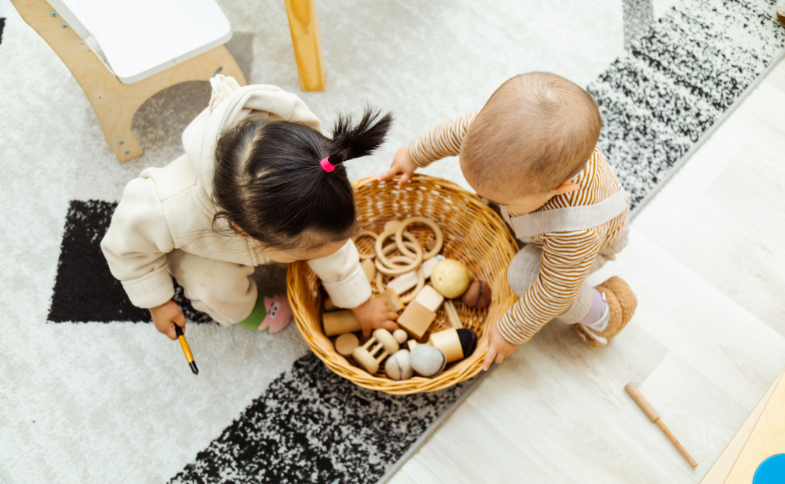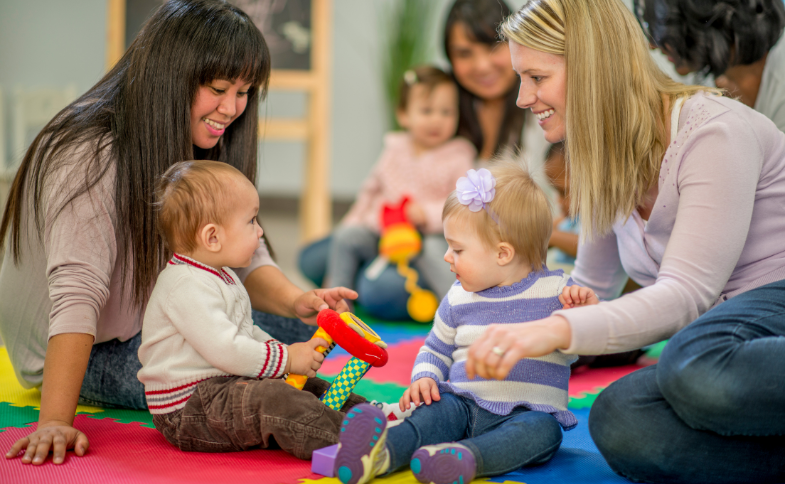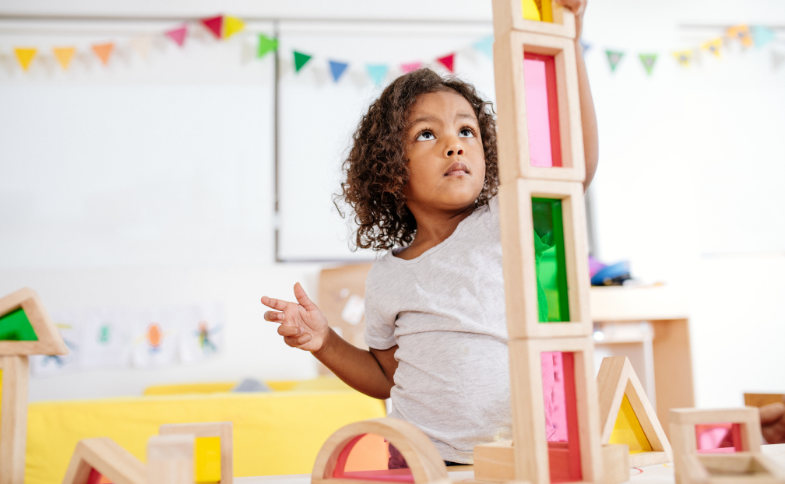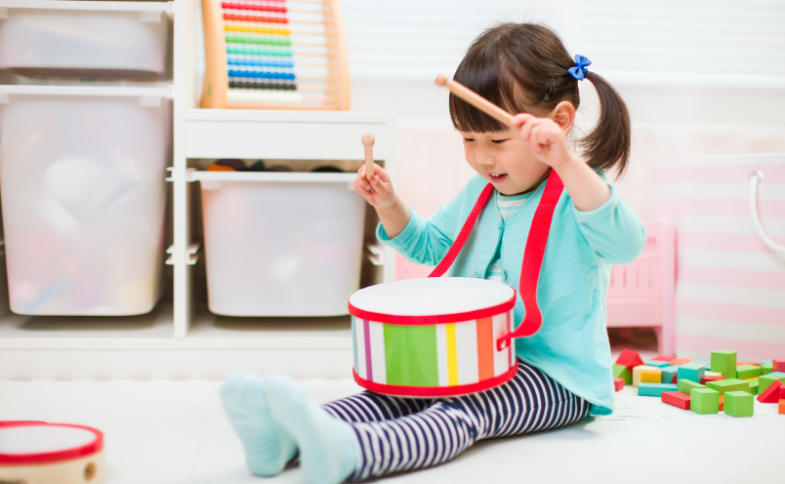DIY Sensory Play for Babies and Toddlers
Playing is an essential part of every child's growth and development. It helps them explore the world around them and learn new things. Sensory play, in particular, is a great way to engage your little one’s senses. It also supports their cognitive, physical, and social-emotional development.
While there are plenty of ready-made sensory toys available in the market these days, creating your own DIY versions can be a fun and cost-effective way to keep your little ones entertained. This is what this guide will focus on. Please also check out our episode on Sensory Play Ideas for Babies.
But first, let’s talk about what sensory play is exactly.

What is Sensory Play?
Sensory play is any activity that stimulates one or more of the five senses: sight, sound, touch, taste, and smell.
It encourages children to use their senses to explore different textures, colors, sounds, and scents. This helps them develop their sensory processing skills.
Sensory play offers numerous benefits for babies and toddlers, including:
- Cognitive Development: Sensory play activities help children develop problem-solving skills, memory, and concentration.
- Fine Motor Skills: Playing with different textures and materials helps improve hand-eye coordination and fine motor skills.
- Language Development: As children explore new materials, they learn to describe and label what they see, hear, and feel, expanding their vocabulary.
- Creativity and Imagination: Sensory play encourages children to think outside the box and use their imagination.
- Emotional Regulation: Engaging in sensory activities can be calming and soothing for children, helping them manage their emotions.
DIY Sensory Play Ideas
Here are some easy and affordable DIY sensory play ideas to try with your little one:
1. Sensory Bags
Sensory bags are a fantastic way to engage your child's senses and provide tactile stimulation. They are easy to make and can be tailored to your child's interests. Here's how to make them:
Materials:
- Clear resealable plastic bags
- Various fillings (e.g., colored hair gel, shaving cream, dry rice, pasta, water beads, aqua gems, colorful pom-poms, cotton balls, etc.)
Instructions:
- Choose Fillings: Select a variety of fillings that offer different textures, colors, and sounds. Each filling provides a unique sensory experience.
- Fill the Bags: Fill each bag about halfway with the chosen fillings.
- Seal the Bags: Carefully seal the bags to prevent leaks. You can add packing tape for extra reinforcement.
- Explore and Play: Let your child explore the sensory bags by squeezing, shaking, and manipulating them. Encourage them to describe what they feel and see. Here are some more play ideas:
- Place the bags on a light table or windowsill to create colorful sensory effects.
- Hide small objects within the bags for your child to find.
- Use the bags to create obstacle courses or sensory bins.
- Encourage your child to sort the fillings by color, texture, or size.

Benefits of Sensory Bags:
- Sensory bags promote sensory exploration and development.
- They help improve fine motor skills and hand-eye coordination.
- Sensory bags provide a calming and soothing effect for children with sensory processing disorders.
- They are a mess-free and portable activity that can be enjoyed anywhere.
2. Sensory Bins
Sensory bins are larger containers filled with various materials that allow children to dig, scoop, and explore with their hands. Here are some ideas for sensory bin fillings:
- Dried beans or lentils
- Kinetic sand or moon sand
- Shredded paper or tissue paper
- Water with food coloring or soap bubbles
3. Playdough
Homemade playdough is a classic sensory material that's easy to make and can be customized with different colors and scents. Here's a simple playdough recipe:
Ingredients:
- 2 cups all-purpose flour
- 1 cup salt
- 2 tablespoons cream of tartar (optional)
- 2 cups water
- 2 tablespoons vegetable oil
- Food coloring (optional)
- Essential oils or extracts for scent (optional)
Instructions:
- Mix the flour, salt, and cream of tartar (if using) in a saucepan.
- Add the water and oil and stir until well combined.
- Cook over medium heat, stirring constantly, until the mixture forms a dough-like consistency.
- Remove from heat and knead until smooth.
- Add food coloring or scents (if desired) and knead until evenly distributed.
4. Finger Painting
Finger painting is a classic sensory activity that allows children to explore different textures and create their masterpieces. You can make your own edible finger paint with ingredients like:
- Yogurt or pudding
- Cornstarch and water
- Mashed fruits or vegetables
5. Sensory Bottles
Sensory bottles are a great way to stimulate your baby's senses and provide a calming or engaging activity. They are easy to make and can be tailored to your baby's individual interests. Here are some ideas for what to include in your sensory bottles:
- Glitter and water: This is a classic sensory bottle that is always a hit with babies. The glitter sparkles and moves around in the water, creating a mesmerizing effect. You can use different colors of glitter to create a variety of looks.
- Colored rice or pasta: This is another easy-to-make sensory bottle that is great for exploring textures. You can use different colors of rice or pasta, or mix them together to create a unique look.
- Beads or pom-poms: Beads and pom-poms add a fun, tactile element to sensory bottles. Babies can shake the bottle to hear the beads or pom-poms rattle around, or they can explore them with their fingers.
- Vegetable oil and food coloring: This is a more calming sensory bottle. The vegetable oil creates a slow, swirling effect, and the food coloring adds a touch of color.
- Scented water: You can add a few drops of essential oil to the water in your sensory bottle to create a scented experience. This is a great way to relax your baby or to stimulate their sense of smell.
- Nature items: You can also add nature items to your sensory bottles, such as leaves, flowers, or rocks. This is a great way to bring the outdoors in and to help your baby learn about the natural world.
When making sensory bottles, be sure to use clear plastic bottles so that your baby can see the contents. You can also use different sizes and shapes of bottles to create different effects. And don't forget to seal the bottles tightly to prevent leaks.
Sensory bottles are a great way to keep your baby entertained and engaged. They are also a great way to support your baby's sensory development.

6. Water Play
Water play is a fun and refreshing way for kids of all ages to cool off and learn about the properties of water. It can also help kids develop their fine motor skills and problem-solving abilities.
Here are some ideas for water play activities:
- Set up a water table. A water table is a great way for kids to play with water in a contained environment. Fill the water table with water and add some toys, such as cups, bowls, sponges, and funnels. Kids can splash and play in the water, and they can also use the toys to experiment with different ways to move and pour water.
- Fill a bin with water. If you don't have a water table, you can fill a large bin or bathtub with water and add some toys. Kids can play in the bin just like they would in a water table.
- Have a water balloon fight. Water balloon fights are a classic summer activity. Fill up a bunch of water balloons and have a fun battle with your kids.
- Play with a water hose. On a hot day, there's nothing more refreshing than playing with a water hose. Kids can spray each other with the water hose, or they can use it to water the plants or wash the car.
- Go swimming. Swimming is a great way to cool off and get some exercise. Take your kids to the pool, the beach, or a local lake for a refreshing swim.
Water play is a great way for kids to learn and have fun. It's also a great way to bond with your kids and create lasting memories.
7. Touch and Feel Book
Create a touch and feel book by gluing different materials, such as sandpaper, fur, and feathers, to the pages of a book. Let your child explore the book with their hands. Creating a touch and feel book is a delightful way to engage your child's senses and encourage their tactile exploration.
8. Sensory Walk
Taking a sensory walk outside is a great way for children to explore their environment and learn about different textures. Here are some tips for making the most of a sensory walk:
- Choose a safe and interesting location. A park, nature trail, or even your own backyard can be a great place for a sensory walk. Make sure the area is free of hazards such as sharp objects or poisonous plants.
- Encourage children to use all of their senses. In addition to feeling the different textures of the ground, children can also listen to the sounds of nature, smell the fresh air, and look at the colors and shapes of the plants and trees.
- Ask children questions to help them focus their attention. What does the grass feel like? Is the pavement smooth or rough? Can you find any soft or squishy surfaces?
- Provide children with opportunities to explore other sensory experiences. In addition to walking on different surfaces, children can also touch leaves, flowers, and rocks. They can also play in the dirt or sand, or splash in a puddle.
- Make the walk a fun and enjoyable experience. Children are more likely to learn and explore when they are having fun. So make sure to keep the walk light and playful.
Here are some additional ideas for activities you can do on a sensory walk:
- Nature scavenger hunt: Create a list of different textures that children can find on their walk. For example, they might look for something soft, something rough, something smooth, and something squishy.
- Texture collage: Collect different natural materials on your walk, such as leaves, flowers, and rocks. Then, use these materials to create a collage on a piece of paper or cardboard.
- Nature soundscape: Record the sounds of nature on your walk, such as birds singing, leaves rustling, and water flowing. Then, listen to the recording at home and try to identify the different sounds.
- Nature mandala: Create a mandala using natural materials, such as leaves, flowers, and rocks. Mandalas are circular designs that are often used for meditation and relaxation.
- Nature journal: Keep a journal of your sensory walk experiences. Write down what you saw, heard, smelled, and felt. You can also draw pictures or make sketches of the things you saw.

9. Treasure Basket
A treasure basket is a simple but effective way to provide your baby with a variety of sensory experiences. It can be made using a variety of materials, such as a wicker basket, a plastic storage bin, or even a cardboard box. The key is to fill the basket with a variety of interesting objects that your baby can explore with their hands and mouth.
Some good items to include in a treasure basket are:
- Keys
- Coins
- Toys
- Wooden blocks
- Fabric scraps
- Feathers
- Shells
- Rocks
- Plastic cups
- Small balls
When you first introduce your baby to the treasure basket, let them explore it at their own pace. They may be hesitant at first, but eventually, they will start to reach in and touch the objects. As they play, encourage them to talk about what they are seeing and feeling. This will help them to develop their language skills and their understanding of the world around them.
The treasure basket is a great way to keep your baby entertained and engaged. It is also a wonderful way to promote their sensory development and their learning.
Here are some tips for creating a treasure basket:
- Choose a variety of objects that are different in size, shape, texture, and color.
- Make sure that the objects are safe for your baby to put in their mouth.
- Avoid using objects with sharp edges or small parts that could be a choking hazard.
- Rotate the objects in the basket regularly to keep your baby interested.
- Observe your baby as they play with the treasure basket and take note of their interests. This will help you to choose objects that are most appropriate for your baby's development.
The treasure basket is a valuable resource for any parent who wants to provide their baby with a rich and stimulating environment. It is a simple and inexpensive way to promote your baby's development and learning.
10. Sensory Soup
Create a delightful sensory experience for your child with a sensory soup. Gather various ingredients like rice, beans, pasta, and water.
Step 1: Prepare the Ingredients
- Measure out equal parts of rice, beans, and pasta.
- Fill a large pot with water and bring it to a boil.
- Add the ingredients to the boiling water and let them cook until tender.
Step 2: Cool the Soup
- Once the ingredients are cooked, remove the pot from the heat and let it cool completely.
- Transfer the soup to a large bin or sensory table.
Step 3: Let Your Child Explore
- Encourage your child to explore the soup with their hands and feet.
- Let them feel the different textures of the rice, beans, and pasta.
- Talk to your child about the different colors and shapes in the soup.
Step 4: Add Additional Textures
- Enhance the sensory experience by adding other items to the soup, such as small toys, sponges, or feathers.
- This will provide your child with a variety of textures to explore.
Step 5: Sensory Play
- Allow your child to play with the soup for as long as they like.
- Encourage them to experiment with different ways of mixing, pouring, and scooping the soup.
- This sensory activity is a great way to encourage creativity and exploration.
Step 6: Clean Up
- When your child is finished playing, help them clean up by draining the soup and rinsing the bin or sensory table.
- Let the ingredients dry completely before storing them.
Sensory soup is a fun and educational activity that is perfect for toddlers and preschoolers. It is a great way to engage their senses and encourage exploration.
Be Safe!
While sensory play is generally safe, it's important to supervise your child at all times and ensure that the materials you use are non-toxic and age-appropriate. Avoid using small objects that could pose a choking hazard for younger children, and always supervise your child during sensory play activities. Read more about this in our guide to creating a safe and engaging environment for your kiddo.
Final Thoughts
DIY sensory play is an excellent way to engage your child's senses and promote their overall development. These are just a few ideas to get you started.
When you create your own sensory play activities, you can provide a fun and stimulating environment for your kiddo. At the same time, you encourage their creativity and curiosity. As you can see, there are endless possibilities when it comes to DIY sensory play. Just use your imagination and have fun! Good luck!